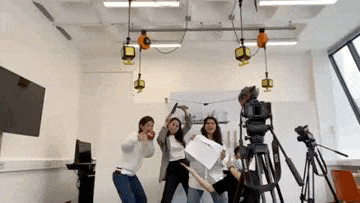Final Outcome: A design and evaluation method
Micro UX - Week 7

Brief: Design the social relations and interactions between a robot chef and its human guests.
External Partner: Moley Robotics
Team: Tiana, Ana, Sanjana, Sylvester
The last week of the Micro UX project persisted intense for us. We have 16 videos to shoot and edit and some other materials, including a web page and a manual to prepare to show our design idea. On the other hand, considering feedback from other groups in previous speed dating, communication remains a crucial part of the final presentation.
Cameras ready…action!
We spent Friday and Saturday setting up our kitchen in D303 and shooting videos. Presenting real food is essential to make it real. Therefore, Sanjana and Tiana, who cast the robot and guest, had to make caesar salad 16 times in different modes. Thank you for putting in such hard efforts! Ana took the role of director and producer in overall management. Meanwhile, I was handling cameras and GoPro in shooting and file management. On Saturday afternoon, we finally finished all videos and split them for editing back home.


Refining the outcome
In general, all the videos are of good qualities. But we noticed that they all look pretty similar and could cause confusion when presenting at the same time. Tiana tried to make some intro animations, which we collectively edited in each video to ease the trouble. Sanjana led us to build a Wix webpage presenting all videos in the grid format, projecting all films in the research framework. Ana and I worked on organising presentation to communicate the progress since midpoint meetings. On Wednesday, Tiana proposed designing a manual to involve detailed settings and descriptions of each mode. We spent our last day running around the campus to finish printing, binding. Fun and exhausted.
So, what is the outcome?
We speculate different scales of human-robot social relations and physical interactions with matrix and provided multiple modes in a domestic cooking robot scenario. Instead of a static form in robot design, the method offers a systematic way to design, coordinate and evaluate various degrees of robot interactions. For Moley Robotics, the practice and videos show a larger avenue of scenarios within the current framework, and benefit them in deciding which one to offer. Moreover, a similar process could help other robot companies to develop their robot behaviours.
👉🏻 Visit the web page with all videos and the relations-interactions grid.

Project Reflection
We asked James before whether Moley Robotics had similar research. Based on James’ feedback, this is a novel research topic and method for his company and probably the robot industry. He considered our design to answer the brief very well, mainly not limited to one specific interaction but a scale of coordinating human and robot counterparts in fruitful scenarios. The booklet turned out an excellent way for him to bring the idea to other partners in the company. Charle from Brixton Pounds also appreciated the humour and humanity in our presentation. He enjoyed how we present our in-depth thinking using live role-play. The project also evoked those who first saw it to think how this speculative future will affect our daily routine, echoing our initial design intention. Worries, excitements, hesitations mix when the robot makes decision automatically and feel close to human. At first, it is confusing for me to identify the desired design outcome as a research method. But John and Al gave us a lot of push and suggestions on the direction. I feel delighted when James recognise the concept and keen to share it with his partners. In the meantime, all the time we spent in prototype making, video shooting and last-minute manual designing show their value in communicating the complex idea to the audiences. One critical point is that we have proposed a design method, but didn’t really have the chance to put it into actual practice. But overall, this six-week project is successful. Special thanks to my team with Sanjana, Ana and Tiana. I enjoyed working with them and learned so much from culture, food, language to design skills. Cover photo by Sebastian Ervi.